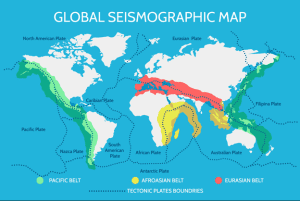TAG: GS 1: GEOGRAPHY
THE CONTEXT: On April 5, an earthquake with a preliminary magnitude of 4.8 struck near New York City, surprising residents in a region unaccustomed to major seismic activity.
EXPLANATION:
- Unlike areas on the West Coast, such as California, where earthquakes are more common due to their proximity to tectonic plate boundaries, the East Coast, including New York, experiences fewer earthquakes.
- This event raises questions about the causes of earthquakes in the region and why they are rare occurrences.
Causes of the New York Earthquake
- The exact fault line responsible for the earthquake is unclear.
- Fault lines are fractures in the Earth’s crust that allow tectonic plates to move, resulting in earthquakes.
- The Ramapo Fault in New Jersey, stemming from the Appalachian Mountains, is a major fault line in the area.
- Additionally, there are at least five smaller fault lines under Manhattan.
- However, pinpointing the specific fault line of an earthquake on the East Coast is challenging due to the absence of nearby plate boundaries for study.
Rareness of Earthquakes in New York
- Geographic Location:
- Unlike the West Coast, which is near tectonic plate boundaries, the East Coast is not located near these boundaries.
- Historically, the land that is now New York experienced significant seismic activity due to continental collisions millions of years ago.
- However, the fault lines in the region have become less active over time.
- Stress Release:
- Earthquakes on the East Coast, including New York, are often attributed to the release of stress accumulated from previous geological events.
- The settling down of stresses from past seismic activity contributes to occasional earthquakes in the region.
- These earthquakes are a result of the gradual settling of stresses over time.
- Long-term Effects:
- The seismic activity experienced on the East Coast, while infrequent, is a remnant of geological processes from millions of years ago.
- The gradual release of stress from these processes continues to manifest in occasional earthquakes, albeit on a smaller scale compared to regions near active plate boundaries.
Earthquake:
- Earthquakes are the result of sudden movement along faults within the Earth. The movement releases stored-up ‘elastic strain’ energy in the form of seismic waves, which propagate through the Earth and cause the ground surface to shake.
- Such movement on the faults is generally a response to long-term deformation and the buildup of stress.
- Seismic waves from large earthquakes pass throughout the Earth. These waves contain vital information about the internal structure of the Earth.
- As seismic waves pass through the Earth, they are refracted, or bent, like rays of light bend when they pass through a glass prism.
- The Earth’s outermost layer is fragmented into about 15 major slabs called tectonic plates. These slabs form the lithosphere, which is comprised of the crust (continental and oceanic) and the upper part of the mantle.
- Tectonic plates move very slowly relative to each other, typically a few centimeters per year, but this still causes a huge amount of deformation at the plate boundaries, which in turn results in earthquakes.
What drives the movement of tectonic plates?
- Below the tectonic plates lies the Earth’s asthenosphere. The asthenosphere behaves like a fluid over very long-time scale. There are a number of competing theories that attempt to explain what drives the movement of tectonic plates.
- Mantle convection currents: warm mantle currents drive and carry plates of lithosphere along a like a conveyor belt.
- Ridge push (buoyant upwelling mantle at mid-ocean ridges): newly formed plates at oceanic ridges are warm, so they have a higher elevation at the oceanic ridge than the colder, more dense plate material further away; gravity causes the higher plate at the ridge to push away the lithosphere that lies further from the ridge.
- Slab pull: older, colder plates sink at subduction zones because, as they cool, they become denser than the underlying mantle and the cooler, sinking plate pulls the rest of the warmer plate along behind it.


